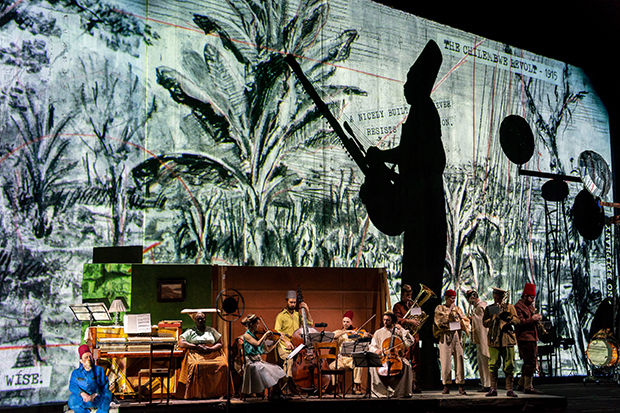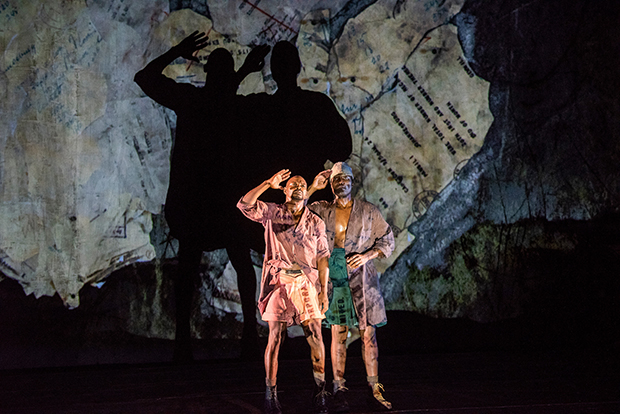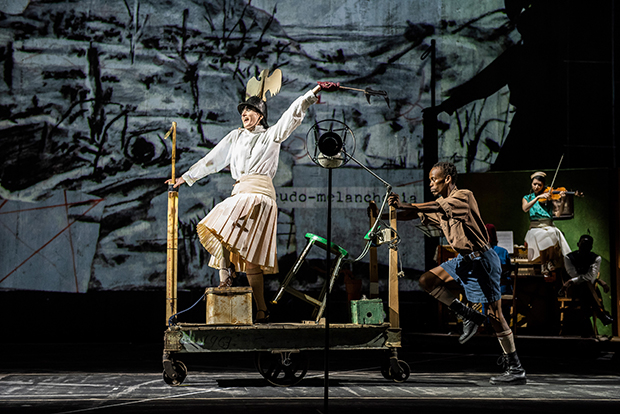The Head & the Load Tells the Hidden History of World War I in Africa

(© Stephanie Berger)
Two million Africans participated on both sides of World War I, and chances are, you don't know the names of any of them. In a year in which so much art is being produced to commemorate the centenary of the armistice, South African director and visual artist William Kentridge has created The Head & the Load, which recognizes the mostly involuntary and completely overlooked contributions of African veterans in stunningly grand fashion. The outsize piece is naturally playing Park Avenue Armory, where its boundary-pushing ambition feels right at home.
The title derives from the Ghanaian proverb, "The head and the load are the troubles of the neck," an apt saying considering that Africans were overwhelmingly conscripted by the French, British, and Germans as porters, or "carriers." They would haul supplies and weapons from battlefield to battlefield, experiencing conditions significantly harsher than that of their European colleagues. That story is heartbreakingly told in a scene featuring two porters (Thulani Chauke and Gregory Maqoma) standing at attention. As one struggles in exhaustion to stay on his feet, his comrade attempts to prop him up and slap him awake, knowing that if he falls, he will most likely be abandoned — a loose screw in a giant, unstoppable machine.

(© Stephanie Berger)
Kentridge's production is overwhelming, forcing us to feel the immense weight of a subject few of us have ever paused to contemplate. He utilizes the full length of the Armory's drill hall, most impressively in a grand procession to war that is as striking as the procession in the Met's production of Aida. Actors trudge across the stage carrying giant cutouts of baggage and military hardware. They cast tall shadows on the upstage wall, which are supplemented by Catherine Meyburgh's projection design (it is difficult to tell the live shadows from the prerecorded ones). Actors and musicians emerge from the giant crates and moving platforms in Sabine Theunissen's set, while Greta Goiris's expansive costume plot creates looks that are both familiar and alien (a hat transforms one actor into a loudspeaker, while a gas mask shrouds another in sinister anonymity).
Our heads dart from side to side trying to keep up with Gregory Maqoma's dynamic choreography, which synthesizes West African dance with military drills. Kentridge's deliberate pacing and grand geometry is reminiscent of the constructivist spectacles of Vsevolod Meyerhold, adding an African flavor to the avant-garde styles that emerged from Europe in the early 20th century. To really appreciate the epic scope of his vision, I recommend sitting near the back of the house.
The aural landscape is just as vast: Composers Philip Miller and Thuthuka Sibisi borrow musical phrases from European modernists like Arnold Schoenberg and Erik Satie and mix them in with traditional African music. Sung and spoken words in English, French, German, Swahili, siSwati, and isiZulu (to name a few) ring out over angry staccato and lush melodies, often progressing in startlingly different rhythms. The result is a violent cacophony that occasionally settles into harmony of unspeakable beauty. It is at least as arresting to the contemporary ear as Stravinsky's "Rite of Spring" must have been to listeners in 1913. If you heard The Head & the Load on SoundCloud, you would marvel at the months it must have taken for the composer to splice it all together, which is why it is even more astounding that all of the music in this show is performed live.
Sibisi (who also serves as music director) has achieved the herculean feat of holding together the vocalists and instrumentalists without the benefit of a conductor. The evening features innovative playing (at one point, a musician strikes the strings of a double bass with drumsticks) as well as more iconic sounds: The muscular brass section seems to herald the end of the world as the armies of Europe march across Africa.

(© Stephanie Berger)
Several performances stand out: Armed with his kora and clarion tenor, N'Faly Kouyate holds strong against dissonant hordes sweeping across the stage. A general in her own right, Ann Masina brings them to order with a chill-inducing call-and-response. Joanna Dudley delivers an unforgettable performance as a shrieking German eagle with a severe bowl cut. We can't take our eyes off of her, barely noticing the African porter (a stoic Xolani Dlamini) pushing her cart across the stage.
And that seems precisely Kentridge's point: It's easy to remember the great commanders and decorated heroes, but we rarely give any thought to the support units without which war is impossible. The Head & the Load asks us to consider what it means to serve on behalf of a colonial occupier, and how the Great War shaped the Africa of today. If we're going to claim it as a "world war," it's about time we start thinking about its global ramifications.










